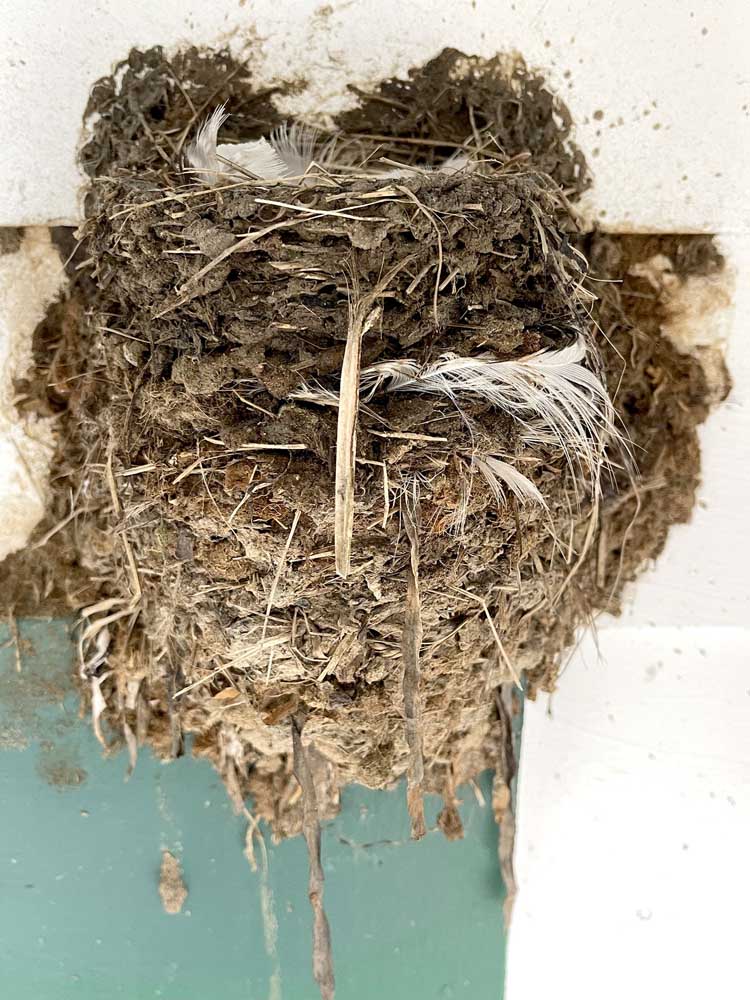Nest-in-a-nest: Recycling and reusing in the bird world
Published 2:45 pm Thursday, June 2, 2022

- Feathers are beginning to be added to the new mud nest by this nest builder.
A recent conversation with Sydney Stevens about barn swallows and their nests resulted in an interesting question. She and Barbara Canney, her friend, noticed a “nest-within-a-nest” in Sydney’s “kitchen garden.” The question that came to mind was, “Is this a common occurrence?” This led to other questions: What other birds reuse their nests? And why do they bother to reuse their old nests anyway?
Trending
Swallows, swifts, and raptors are the recyclers and re-users of the bird world, at least as far as nest building goes. Barn swallows, for example, will reuse a nest many times over and year after year. In addition, a new pair will reuse another pair’s old nest. Barn swallows are often called recyclers by scientists. Sydney Steven’s swallows have been nesting in the ‘kitchen garden’ for more than 40 years. “The earliest arrivals seem to go right to the spots where there have been nests year after year.” Nests that survive the ravages of winter are likely to be reused. Barn swallows that reuse a nest usually remove the old feathers that lined it. They then add fresh mud to the rim of the used nest. It must be time saving, to say the least!
Bald eagles, like other raptors build very large nests, but bald eagles build some of the largest. They will reuse their nest for many years if they experience breeding success. Thus, they are usually faithful to such a nesting site year after year after year. Cornell Ornithological Lab. reports that one bald eagle nest was used for 34 years until the tree it was in blew down. Renovation is what most raptors engage in yearly. New sticks are added to the old nest such that its size increases as the years pass. Some eagle nests that have been used for many years have been estimated to weigh more than a ton. The 34-year-old nest was thought to weigh more than 2 tons (Cornell lab). Other raptors such as the red-tailed hawk, also tend to reuse an old nest. If so, they will renovate it yearly. Great horned owls help the environment too by recycling. They are not equipped to build their own nests, so they use an old raptor’s nest.
Raptors and other birds like most species, usually return to the same area to breed each year. I think it makes sense that they would recycle and reuse their old nest. It would be a time saver. Renovation is a lot faster than building from scratch. Perhaps it is just convenient since they return to their old stomping grounds!
Trending
Most birds do not reuse their old nests. Building a new one reduces the chance of parasites, such as mites, laying their eggs in the nesting material and hatching in time to attack the fledglings. According to science nest boxes don’t always have to be cleaned out because many birds will do the clean-up job themselves. However, it doesn’t hurt to help the birds that choose to nest in boxes with this house cleaning chore. It is said, that building a new nest may also serve to keep predators at bay. Choosing a different site in which to set up house could make it more difficult for predators to locate the nest when it is filled with nestlings.
Nest building can be part of the mating ritual. This is the case for wrens. The male house wren will build several nests which he presents as choices to his potential mate. She gets to choose the ultimate location. I have a wren nesting box in the yard which is sometimes chosen but at other times is not. The location doesn’t always seem to suit the female house wren. There is some evidence that wrens will reuse an old nest, but generally they abandon it.
Recycling and reuse, as we have all learned, is a very good thing. Many bird species think so too! Happy birding.









